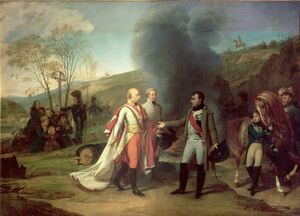What Lunacy Persist
The main page for What Lunacy Persist
Point of Divergence[edit | edit source]
On the 1st of December, 1805 the day before the Battle of the Three Emperors a meeting was conducted between the allied forces of the coalition against Napoleon's forces whom had just succeeded in claiming the Austrian capital of Vienna. The allied forces were under the command of Russian Tsar Alexander I, Russian Field Marshal Mikhail Kutuzov, and the Holy Roman Emperor Francis II. The discussion and creation of the plan of battle was conducted just outside of the town of Austerlitz. In the drawing up of battle plans, the Russian nobility pushed for a more committed attack on the more exposed and weakened French right flank, and a sweeping assault southward to hook up communications with Vienna. However, one of the biggest critics of the plan was the Emperor of Austria, Francis II. He advocated for a safer approach to the upcoming battle, believing that the apparent exposed right flank of the French military was simply a diversion set up by Napoleon to lure in the majority of the Allied forces.
The deliberation of the battle plan was long and arduous between the two sides, with Francis II even ready to simply abandon the Russian forces there on the spot and retreat back to a more defendable position. All the while Alexander I was ready to charge headlong into the battle right there on the spot. But, the stubborn Tsar eventually gave in to the Emperor's strategy at the behest of Alexander's Field Marshal, Mikhail Kutuzov.
On the morning of December 2nd, 1805 the Battle of Austerlitz commenced. Bonaparte eager to secure a victory over the last continental threat to his ambitions of Europe was met by a combined Russian and Austrian force that had dug themselves into just beyond the Littalawa River, just outside the range of French artillery. Bonaparte began moving his right flank closer to try and entice the Coalition forces to take the bait, but they were only fired upon. Bonaparte frustrated ordered for the delay Davout and his forces as he repositioned his forces.
Bonaparte's strategy was to sweep in from the Austrian and Russian right flank, forcibly turning to expose their left flank and allowing Devout and his men to charge in and secure the victory. As Bonaparte reorganized his men and ordered commanders Lannes and Bessieres to pincer in from the right flank, with the artillery following in suit. In the process of the movement, Bonaparte had encountered a much smaller fighting force than initially reported, and immediately called for a return to the original formation.
Though he was not able to reorganize fast enough as a majority of the Austrian forces under Kollowrat and Russian commander Baragtion swept in from the exposed flank of the French, sweeping in and capturing Bonaparte's artillery. The flanking Coalition forces inflicting heavy casualties on the forces commanded by Lannes, Bessieres, Bernadotte, and Murat forcing a full fledged retreat as the rest of the Coalition forces pushed forward and routed the rest of his men. A simple miscalculation of enemy forces had caused Napoleon one of his greatest defeats, and would leave him bitter and enraged at the Austrians and Russians.
By midafternoon Austrian and Russian forces had beaten the once thought invincible Napoleon, and had secured victory in Central and Eastern Europe from the general. A simple battle that would soon see the destiny of the world changed forever.
